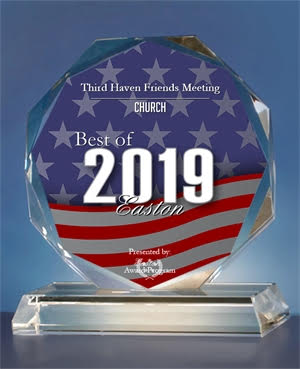
What does it mean when a town goes out of its way to name your monthly meeting the “Best of” all churches in the region? It means that the outreach, children’s programming and spiritual life committees’ hard work and innovative approaches have been working — the meeting has pulled together creative and compelling programming well-aligned with community needs.

Third Haven has manned many a Easton, MD, fair table, welcomed community to monthly films on environmental issues, opened a new summer day camp for nearby families, and made its historic 1684 meeting house a museum serving tourists during daylight hours. It is open to the public seven days a week 52 weeks a year. It renovated its community room several years ago and is engaging in campus master planning to support visionary thinking about how to use their space to better meet emerging needs for pedestrian traffic, children’s programs and fire code issues.
 Still, they were very surprised to be nominated for the 2019 Best of Easton Awards, and to win in the category of Church.
Still, they were very surprised to be nominated for the 2019 Best of Easton Awards, and to win in the category of Church.
Molly Burgogne, clerk of Third Haven Meeting, notes that “accomplishments this year include not only our summer camps, but our Tiny Tots mornings for mothers and small children (for stories and centering), our environmental grant for stream restoration, our collaboration with University of Maryland archaeology student project and our community environmental Friday night film series.”
She adds “I’m so very proud of our great community.”
They didn’t expect an award for doing what they always do – serving the community in meaningful ways. This August has seen a Thursday Journal group, Wednesday Smart Recovery meetings, a singles end of life group, a Jung study meeting, a basket weaving class, an evening book discussion group, meditation meetings, plus worship and ministry and spiritual journey meetings.
The community also has a long term project on the third Wednesday of each month May through December, where Marilla’s lunches are prepared at and delivered from the Third Haven common room. An article on Third Haven’s website notes that “These lunches are part of the Talbot Interfaith Coalition Against Hunger and originated from the winter soup kitchen that Asbury Methodist (church) has provided for many years. About 13 years ago, the Pastor at Asbury asked, “Why can’t we provide these lunches all year?” And so began the expansion to a full year of delivery of lunches to those in need.”

This year’s July summer camp, hosted a group of 11 kids, led by teachers Kristen Hanlon and Cherie Baron. In the words of Third Haven’s newsletter editor John Hawkinson, children “gathered together over 4 mornings to explore Third Haven during deep, hazy summer days. Set to the music of cicadas calling, the campers shared many adventures: they challenged each other with homemade outdoor obstacle courses; charcoaled the shadows of trees to see their patterns; painted flags showing their gratitude; sewed treasures from our children’s garden onto canvas; and studied pollinators to mimic their flight and silent ways of communicating. We climbed the giant rhododendron bush and read books (always a favorite), then, as needed, ran through the sprinkler by the caretaker’s cottage to cool off. Not only was the week made special by this particularly sweet and gentle group of kids, but also by the proliferation of butterflies, bees and dragonflies who seemed to follow us on all our adventures.”
Far from becoming a drag on the Third Haven budget, the camp has been tremendously financially successful. It has also brought new families to the meeting, and revitalized First Day School.
Some compelling history also envelops Third Haven. The Quakeress Elizabeth Harris is considered the “founder” of Maryland Quakers in 1656, and by 1676 Quakers had expanded their Maryland presence to settle in Talbot County MD. Maryland then proved a magnet for visiting Quaker ministers: George Fox visited the region in 1672-73 drawing some 1000 people to worship near Betty’s Cove in the spring of 1673; John Woolman came to the meetinghouse in 1766.
The meeting’s history is reflective of the region’s settlement and governance practices. There was religious conflict, much Quaker outreach to dissenters displeased with establishment churches, government persecution against tax and militia refusers, plus the caustic impact and damage done by slavery. Some Third Haven members made efforts to address the multi-generational harm caused by slavery (50 acre land plots and homes were paid over to formerly enslaved persons, and educational and fair-market job programs were actively invested in), others waited until 1768 to become active in the abolition movement.

The meetinghouse – which is also a museum – is in its original state with no electricity. William Southeby (the first native-born Quaker to write against slavery) granted lumber for the building, and John Edmundson provided three acres of land in 1682. After a slow start to construction, the meetinghouse first hosted worship in 1684. Nine years later, in 1693, the congregation of the very active Betty’s Cove meeting (which coalesced in the mid 1660s) moved themselves over to the Third Haven Meetinghouse, abandoning the much smaller Betty’s Cove site. About 100 years later (in 1790) Southern Quarter was formed, Third Haven left Maryland Yearly Meeting, and Southern Quarter officially joined Philadelphia Yearly Meeting.